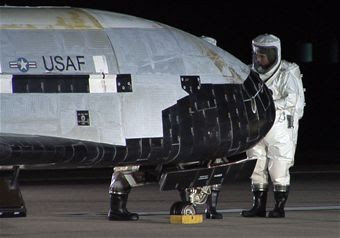
According to Space.com and Mike Wall (Twitter @michaeldwall), the U.S. Air Force's secretive X-37B space plane is poised to launch on its second mission Friday (March 4), though what exactly it will be doing once it leaves the ground remains a mystery.
The robotic X-37B mini-shuttle is slated to lift off from Cape Canaveral, Fla., on Friday atop an Atlas 5 rocket, weather permitting. Its launch window opens at 3:39 p.m. EST (2039 GMT), according to the launch provider United Launch Alliance, which is overseeing the flight.
This will mark the second space mission for the Air Force's X-37B space plane program — but the first for this particular plane. It is the second X-37B spacecraft built for the Air Force by Boeing and carries the name Orbital Test Vehicle 2, or OTV-2.